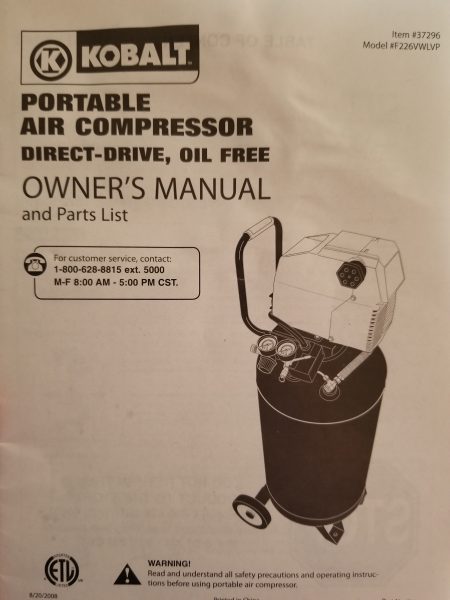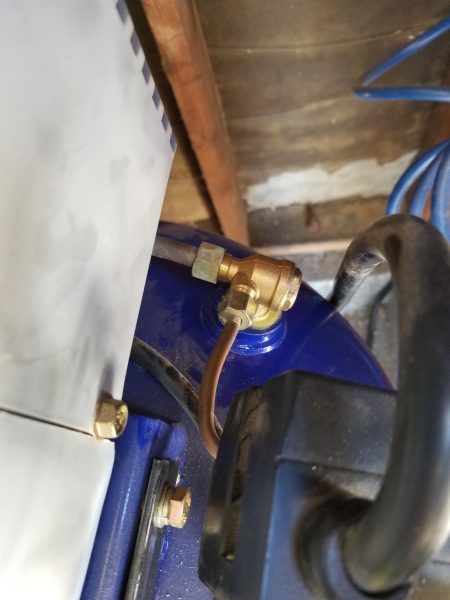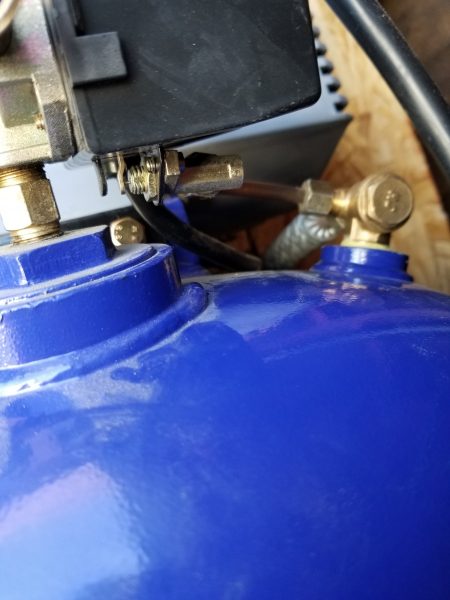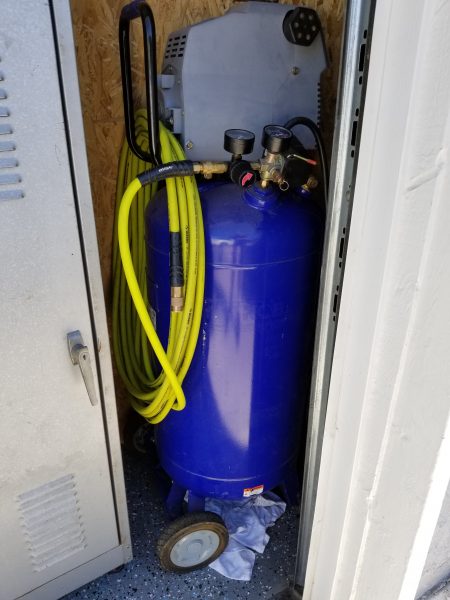I bought this compressor about 8 years ago. Use once a month on average for car and bike tires, etc. Issue 1 – From day 1 it has never held air in the tank for more than a few days.

Issue 2 – about a year ago it would only fill to about 100psi then blow the reset button on side of the engine cover. If I reset immediately then the motor would hum for a few seconds then blow again. I found that the longer I waited before pressing then the longer it would run after I pressed.

As the months have gone by the tank fills less and less before the tripping button so now it fills to maybe 30psi before tripping and then if I wait a minute to push reset I get maybe 15 seconds of run time and then trips then wait and so on.
It took 20 minutes of this game to fill to 100psi last week.

After reading this site I replaced the check valve and the tank has now held pressure for a few days now but the start/stop issues are still there.
I opened the water drain valve on the bottom and emptied it completely and the compressor started fine and ran for 3-4 minutes (though was making a tapping sound toward the end) and then I closed the valve and it filled to only 20psi and tripped reset again.
Thanks for any help. Kevin F.

Kevin, thanks for the question and for taking the time to upload photos. Seeing the compressor in question helps put issues about them into perspective. As you can see, I’ve relocated your original question here.
I am pleased that reading the site lead you to realize that your compressor tank check valve had been leaking all along, and also I am happy that changing it out resolved that issue. There are not a whole lot of expensive, high-quality components in low-cost air compressors, and that includes the mass-produced tank check valves. Possibly the original had a small bit of debris lodged in the seal, or the seal itself had been crimped, who knows? You replaced it and the replacement works well from the sounds of it.
Are you running the compressor while it’s in the storage locker? If so, heat build-up within the locker might be a cause of the 2nd issue, though that’s not a high likelihood.
It sure does sound as though your compressor is intermittently shutting down on high-temperature cut-out, though.
That it runs with the tank drain open means that it’s running without any real load buildup, and that helps prevent the motor from getting too hot and shutting off.
Run it with the tank drain closed and pressure building in the tank means that the motor is undergoing increasing load, that load makes the motor work harder, it heats up and shuts down to protect itself.
Some questions I have are, are you always plugging the compressor into the same socket?
Are you using an extension cord, and if so, are you always using it when the compressor is stopping?
Do you know the amperage of the circuit into which the compressor is plugged?
Are there any other appliances on this same circuit that could be running at the same time you are trying to use the compressor?
All of these questions have to do with the power supply to the compressor. If the power supply is compromised (meaning insufficient power for the motor’s needs) the motor will overheat and shut down.
If, on the other hand, your power supply is good, you are not using an extension cord that’s too small, the circuit amperage is sufficient, then that points to either a problem with the thermal cut out switch itself, the compressor capacitor failing, or the motor itself failing.
If you can comfortably bypass the thermal cut-out on the motor, do it one time and let the compressor run-up to the normal cut-out pressure level. While the compressor pump will get very hot during this, the motor shouldn’t be too hot. That’s subjective I know, but if you can touch the motor without burning yourself, then it may not be getting hot enough to damage the motor, and that points to the thermal cut out itself being the issue. It will need replacing if that’s the surmise.
If the cut-out doesn’t appear to be the issue, then please see the page on this site about compressor motor capacitors to better understand them and how they work, and how to test them.
Please add a comment below with your findings if you would.
Gotta love the warranty on this:
“This warranty is limited to manufacturing defects in the compressor for a 36-month period, ??????? ??? ????????????? ??????? ??????? ?? ??? ?????????? ????, ????? ??????, ???????? ?????? ??? ???????? ????? ? for which the warranty on these “excluded items” shall be for a 12-month period. …”
So I guess that covers the tubes, regulator, tank, and wheels? And maybe whatever the “check values” are?
Anyway, you might also check that the intake filter is reasonably clean and passes air and that the fan is intact and secure, says Doug from s.d.ca.
Thank you for helping me out I am sorry for the late reply but just this week I finally had some time to sort out my compressor.
Update on the leak – replacing the check valve helped but I was still losing air so I tightened the gauges which seemed to help. Apparently they only factory tightened until they looked straight.

I attached a wider angle pic of the compressor. It is actually in the front garage corner not in a locker so airflow is great especially because it only runs when the door is open.
The electrical is 20amp and the extension cord I use is the same size/gauge as the compressor and the setup has been the same during the old days when it worked fine.
I also tested the capacitors (which was a new experience for me and very cool) and they were fine.
So my last step was to bypass the thermal “reset” switch. I did that using a 20amp automotive blade fuse since I had one lying around and started it up. It went all the way to 125psi cutoff without breaking a sweat!
I had a temp gun on the motor inside and outside and it didn’t go over 95 degrees.

So I ordered a new thermal cut-out switch for $10 on Amazon and after installing it today I was able to go from 0-125psi again without shutoff.

Thank you again for your help! Kevin.
